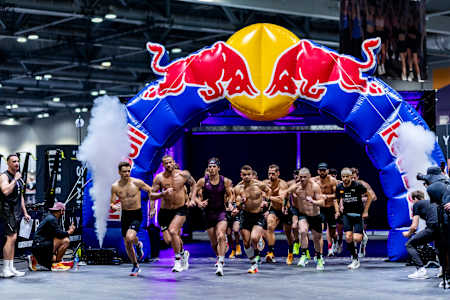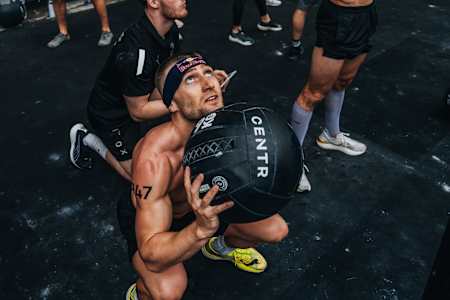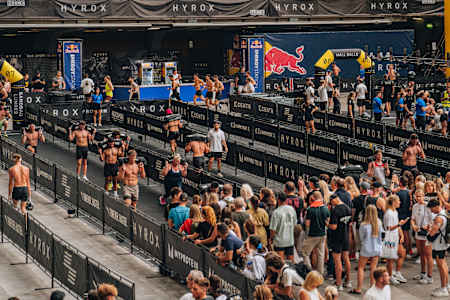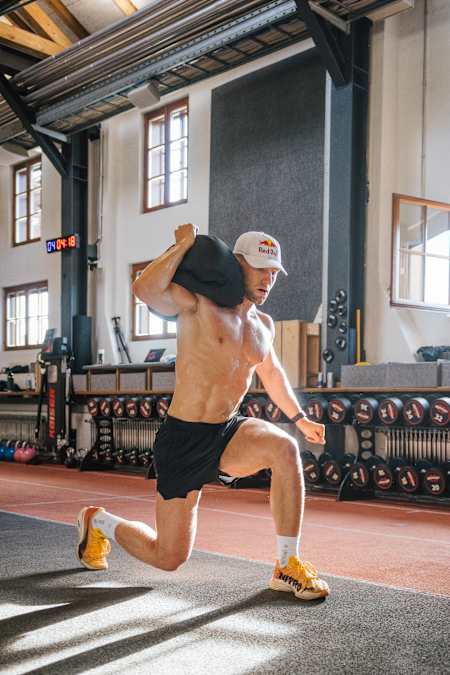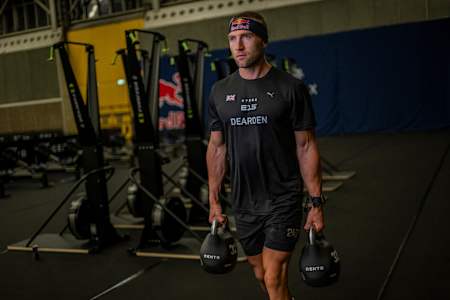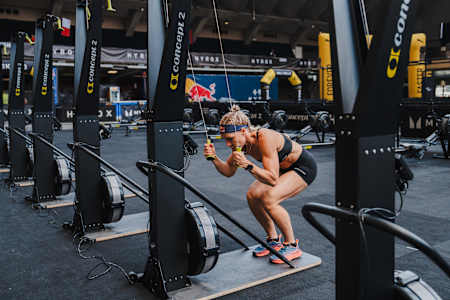
HYROX
How to train for HYROX, according to a HYROX coach and world champion
UK Elite 15 athlete Jake Dearden reveals how to crush HYROX, the biggest mistakes to avoid – and why this brutal fitness race isn’t for the faint-hearted.
HYROX has grown to global fame as the ultimate event to test your fitness - from everything from your quad strength to your mental stamina. And the man who knows all about it? UK's top HYROX athlete and master coach, Jake Dearden. Dearden clinched a coveted spot at the HYROX World Championships with a personal best of 55:43 and a 6th-place finish in Glasgow earlier this year.
Known for his relentless drive and endurance, Dearden secured qualification after months of chasing the individual World Championship dream. While many competitors come from a gym background, Dearden’s secret weapon is his speed on the road: he ran a blistering 2:28 at the 2024 Berlin Marathon – just months after clinching a world title in the HYROX Doubles in Nice, France.
Dearden, who competes in HYROX’s most prestigious category – the Elite 15 – knows exactly what it takes to thrive in the world’s toughest fitness race. From the biggest training mistakes to the mental grit required to push through, one question remains: what exactly is HYROX, and how do you train for something this intense? Dearden breaks it down.
What is HYROX?
HYROX is a full-body functional fitness race that’s as taxing as it is rewarding. “What’s great about it is that anyone, given the right amount of training, can compete, so it’s really inclusive,” Dearden explains. The race combines running segments with challenging full-body strength exercises. It kicks off with a 1km run, then moves into a 1km SkiErg session, followed by pushing and pulling a sled for 50 metres each. Next up are 80 metres of burpee broad jumps, a 1km row, 200 metres of farmer’s carries, 100 metres of walking lunges carrying a sandbag, and wraps up with 100 wall balls.
“Between each station, you do a 1km run, so you’re running a total of 8km over the course,” he adds. “The event can be done solo, in pairs, or as a relay with up to four people – but the main thing is that you’re racing against the clock. It’s pretty tough and usually lasts anywhere from an hour to two hours.”
Why is a tailored training plan so important for HYROX?
Preparing for HYROX isn’t just about being fit – it’s about being functionally fit for the specific demands of race day. With a mix of endurance running and strength-based movements, a generic workout routine won’t cut it. That’s why a personalised training plan, built around the unique structure of HYROX, can make a huge difference to your performance and recovery. According to Dearden:
“It’ll not only improve your fitness and strength, but it will cover all your muscle groups, prepping you for endurance on the day. Some of the movements are quite hard and to get a good time, you really need to be efficient. So first and foremost, practising the movements and making sure that a training programme is tailored towards what you can expect on the day, as well as working on your weaknesses, is definitely going to take minutes off your time. Plan your sessions so you’re getting the balance right between the strength elements like being able to push the sled or complete the walking lunges, combined with the interval running. Obviously having a realistic plan that is tailored around your lifestyle is important; some people, for instance, find it hard to get all of the running in as well as the functional fitness, so it's very important to be able to program effectively as well as allow time for rest.”
Why is rest such an important part of training for HYROX?
When it comes to HYROX training, most athletes focus heavily on building strength and endurance, but recovery is just as crucial. Without adequate rest, your body can't adapt, repair, or improve, and overtraining can actually hold you back from hitting your goals. Incorporating proper rest and active recovery days into your HYROX training plan is essential for both performance and injury prevention. As Dearden explains:
“You need to make sure that you’re having adequate rest days so that you can recover and get a positive semi-stimulus from your training and that your body can repair so you can go again. Think about traditional gym training; you want to allow between 24 and 72 hours for your body to rest, so that’s why active recovery days are important. This could be going for a slower-pace run or even walk so you’re still moving your body but you’re not overdoing it. If you push and don’t give yourself enough recovery time, you can actually hinder your progress and run the risk of injury or battering yourself so much you end up losing strength.”
You want to allow between 24 and 72 hours for your body to rest. That’s why active recovery days are important.
Can anyone compete at HYROX?
One of the biggest draws of HYROX is its accessibility. While the sport attracts elite athletes, it’s also designed for everyday fitness enthusiasts looking for a new challenge. With scalable categories and a clear race format, HYROX welcomes participants of all levels, whether you're aiming to finish your first race or beat a personal best. According to Dearden, the inclusive nature of HYROX is a big part of its global appeal:
“100%. One of the reasons it’s such a success is that it’s really inclusive – it’s not just for super elite fitness people, it’s for everyone. If you’re looking to compete, realistically you probably need around six to 12 weeks to train, and then if you want to improve your time, you might look at extending this training cycle or changing it up for next time.”
01
How do you train for a HYROX event?
HYROX demands a unique blend of strength, endurance, and mental toughness, so generic gym workouts won't cut it. Training for HYROX requires a structured approach that balances heavy compound movements with high-intensity cardio and proper recovery. Whether you're a first-timer or chasing a personal best, building a weekly plan that mirrors race-day conditions is key. As Dearden puts it:
“Training is quite intense! You’ve got high-impact, weight-bearing exercises, including running, and then you've got heavy strength exercises like the sled push and farmer's carries, so you’re putting a lot of pressure and a lot of stress on your body. If I was programming for a client or for myself, I’d plan a weekly training plan of one session each day, with one rest day. An ideal week would include:
- One lower body strength session where you’re putting your legs through their full range of motion. This could include front or back squats, some unilateral work where you’re working on strengthening your legs equally and then some lateral work like side lunges to strengthen your adductors and abductors. I’d probably finish on some heavy sled work, so more than you will be pushing on the day and some box step-ups.
- Two Hyrox conditioning sessions where you’re doing some of the exact exercises like burpee broad jumps and sled pushes and pulls. The aim of this is to work on your metabolic conditioning and get your heart rate up, interspersed with rest periods – so high intensity interval training.
- Two to three runs, consisting of one long run – over the course of your training block, gradually build up to a long run. Ideally this should be for the amount of time you think it’s going to take you to complete the HYROX course on the day (so around 90 minutes). Also do one speed-work running session, for instance on a track where you run eight x 1km with a two- to three-minute rest in between. Then for your third weekly run, try to include some running where you’re under fatigue. This could be hill running or combining running with some leg work, like heavy squats or lunges, so that your body gets used to working under stress and handling that lactic acid.
In terms of practising the course itself, I probably do this every two or three weeks just to get my body used to transitioning between exercises and start building up my strength ready for the event.”
02
What does training look like in the week leading up to a HYROX event?
Jake suggests training six days a week in the run-up to the event
© Joerg Mitter/Red Bull Content Pool
The final week before a HYROX race is all about tapering, not pushing harder. To perform at your peak on race day, you need to reduce intensity, prioritise recovery, and focus on refining technique. This “deload” phase helps your body recover from training while keeping your movement sharp and your mindset focused. Dearden outlines what an ideal race-week plan should look like:
“Most HYROX events are on the weekend, so the week before, use this as a deload week and strip everything back to around 80 per cent effort. You’re not realistically going to improve strength in the week before an event, so be smart and focus on technique and transitions on the Monday and the Tuesday – this is where you can really hone your movement and shave some time off your speeds. On the Wednesday, go for a gentle 5km run and then rest for two days before the event. The main goal is being able to arrive on the day and feel confident that you know the exercises and that you’ve trained hard.”
What are some of the mistakes that people make when they’re training for HYROX?
The Ski Erg is one of the eight workout stations in HYROX competition
© Baptiste Fauchille/Red Bull Content Pool
Even well-prepared athletes can make avoidable errors that cost them time, or worse, lead to penalties. From neglecting technique to skipping the parts they dislike, Dearden shares the most common HYROX training pitfalls:
“There are a few things. First up, getting really good at the one thing that they struggle with. So for a lot of people that might be the sled. They’ll put all their efforts into nailing this and they’ll not focus on doing burpee broad jumps because they think, ‘it’s just a burpee’. But these are incredibly hard and people underestimate the skill it takes to get the technique right. Secondly, avoiding what they don’t enjoy, so for lots of people that might be running. You have to remember that during the course, you’re running 8km, and while it’s split into 1km runs, improving your running will mean you complete the course in a faster time. And finally, not studying the HHYROX rules. Definitely make time to find out the techniques for all the exercises or you may find you face a penalty or you’ll be slowed down. For instance, walking lunges must be completed by standing up fully between lunges as opposed to keeping time under tension and not coming up fully.”





